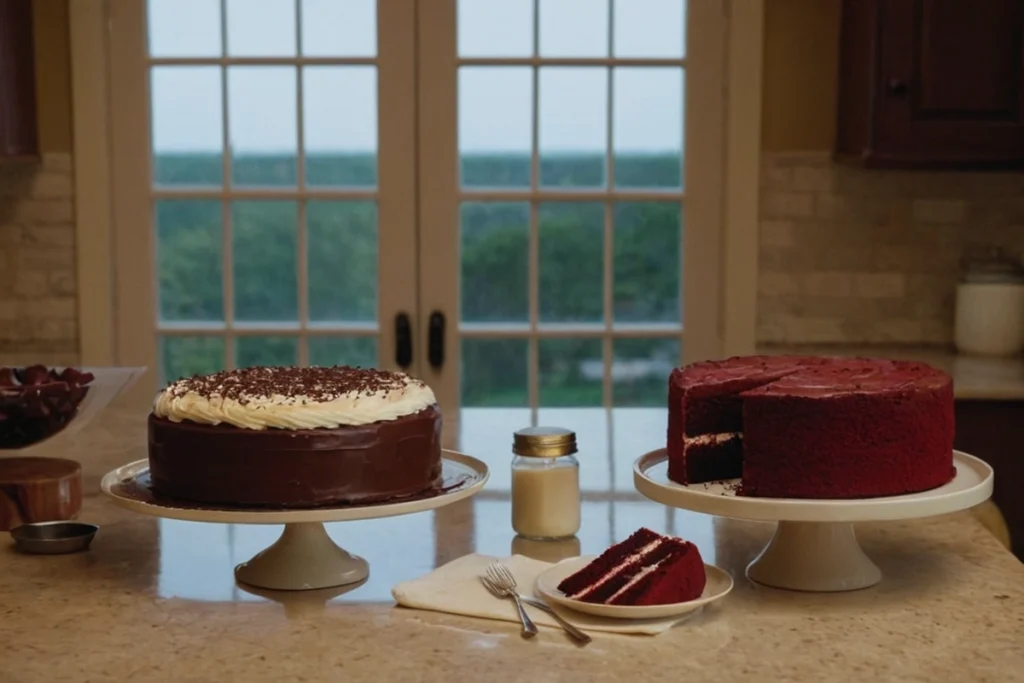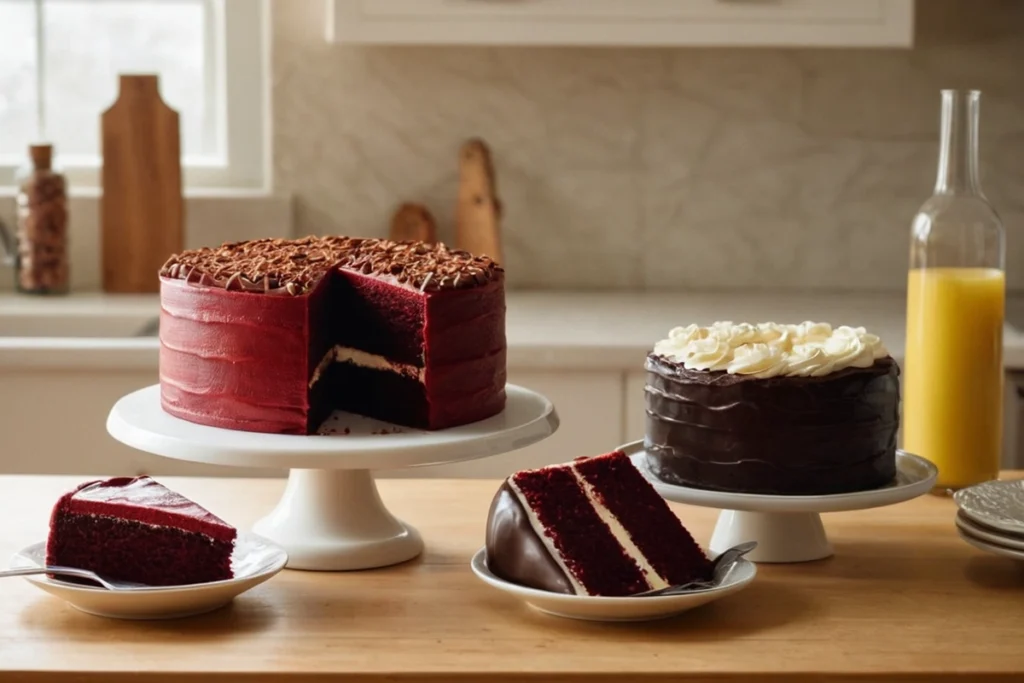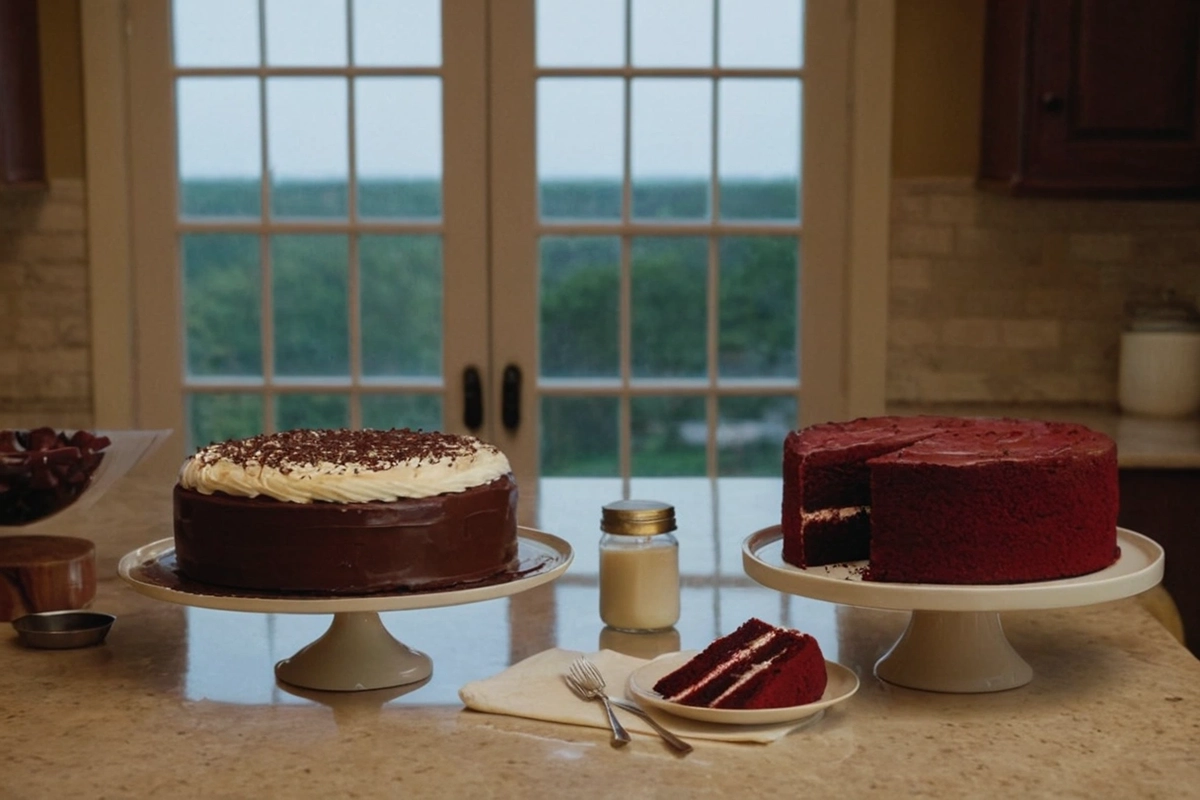Why does red velvet taste different from chocolate cake? Red velvet cake and chocolate cake are two classic desserts that have delighted people for generations. Though they share some similarities, most notably the presence of cocoa powder, they are distinct in both flavor and texture. Many mistakenly believe that red velvet is just chocolate cake with red food coloring, but that’s far from the truth.
In this article, we will explore why red velvet tastes different from chocolate cake by examining the key differences between these two beloved cakes. For another take on velvet cakes, check out this purple velvet cake variation. We’ll explore their origins, ingredients, and baking processes to discover why red velvet tastes different from chocolate cake and how its unique flavor is achieved. If you’re looking to enjoy red velvet in a different form, don’t miss our Red Velvet Brownies recipe for another delicious twist on this classic flavor.
Table of Contents
Origins and History of Red Velvet and Chocolate Cake
The History of Red Velvet Cake
The origins of red velvet cake date back to the 1800s, where “velvet cakes” were a popular dessert. Bakers added cocoa powder to cakes to create a smooth, velvety texture, hence the name. The term “velvet” referred to the fine and soft texture of the cake, which was a result of the cocoa. During this time, cocoa powder wasn’t Dutch-processed, meaning it was more acidic. When combined with ingredients like buttermilk or vinegar, the cake developed a reddish hue. This happened due to the chemical reaction between the acidic cocoa and the vinegar or buttermilk. This red tint became a signature of red velvet cake.
World War II played a role in the evolution of red velvet cakes as well. Due to ingredient rationing, bakers started using beet juice to enhance the red color in velvet cakes. This led to the brighter red appearance we now associate with modern red velvet cake. Today, the use of red food coloring or beet juice is standard in most red velvet recipes.
The Evolution of Chocolate Cake
Chocolate cake has its roots in the early 19th century when cocoa powder became more readily available. Unlike red velvet cake, chocolate cake was designed to highlight the rich, intense flavor of chocolate. Over time, bakers began experimenting with different forms of chocolate like melted chocolate, chocolate chips, and cocoa powder. They created variations of chocolate cakes with different textures and flavors. Some versions, such as German chocolate cake and devil’s food cake, focus on making the chocolate flavor as intense as possible.
The common confusion between chocolate and red velvet cakes likely arises from their similar reddish-brown appearance. However, while chocolate cake emphasizes a rich chocolate flavor, red velvet is known for its more subtle flavor, with hints of cocoa and a unique tanginess from other ingredients.

Flavor Differences Between Red Velvet and Chocolate Cake
The Chocolate Base in Both Cakes
Why does red velvet taste different from chocolate cake? While both red velvet and chocolate cake contain cocoa powder, the amount used is very different, leading to significant flavor differences. A traditional chocolate cake is rich and deeply chocolatey. It’s often made with larger quantities of cocoa powder, chocolate chips, or melted chocolate. This creates a dessert that highlights the intense flavor of chocolate, making it a favorite for chocolate lovers.
On the other hand, red velvet cake contains only a small amount of cocoa powder, resulting in a very subtle chocolate flavor. The emphasis in red velvet is not on the chocolate but rather on the tangy, complex flavors brought about by other ingredients like buttermilk and vinegar. The small amount of cocoa adds depth to the flavor but doesn’t dominate the palate like in chocolate cake.
Red Velvet’s Tangy Twist
The key difference in flavor between red velvet cake and chocolate cake lies in the tartness created by buttermilk and vinegar. These acidic ingredients give red velvet a tangy flavor, balancing the sweetness and adding a subtle complexity that sets it apart from chocolate cake. This tart flavor, combined with the mild chocolate notes, makes red velvet cake unique and different from the rich, deep flavor of traditional chocolate cake.
Moreover, red velvet is often paired with cream cheese frosting, which enhances the tangy flavor. The richness of the frosting adds another layer of flavor, creating a well-rounded dessert experience. On the other hand, bakers usually pair chocolate cake with buttercream frosting or chocolate ganache to accentuate the chocolate flavor even more.
To learn more about the differences in flavor and ingredients between these two cakes, visit this Food & Wine article.
Texture and Ingredients
Texture of Red Velvet Cake
One of the defining characteristics of red velvet cake is its light and tender texture. The use of buttermilk and vinegar in the batter helps to tenderize the cake, giving it a soft, velvety crumb. The acid in the buttermilk and vinegar reacts with the baking soda, creating a chemical reaction that helps the cake rise and maintain its airy structure.
The texture of red velvet is also influenced by the small amount of cocoa powder used. Because red velvet cake doesn’t rely heavily on cocoa for its structure, it remains light and fluffy, with just a hint of chocolate flavor. The end result is a cake that is softer and more delicate compared to the dense, moist texture of chocolate cake.
Texture of Chocolate Cake
In contrast, chocolate cake tends to be denser and richer, particularly when made with melted chocolate or chocolate chips. The high fat content in chocolate contributes to a moist, rich crumb that is often much heavier than red velvet. While chocolate cakes can be light, many traditional recipes focus on creating a more indulgent, dense texture that enhances the chocolate flavor.
Additionally, the use of different types of chocolate, such as Dutch-processed cocoa or baker’s chocolate, can affect the texture and richness of chocolate cake. These ingredients lead to a moist, fudgy cake that contrasts with the lighter feel of red velvet.

Baking Process Differences
Chocolate Cake Baking Techniques
When baking a traditional chocolate cake, the key to achieving the right texture is in the handling of the cocoa or chocolate. Many recipes call for melting chocolate and folding it into the batter, which creates a smooth and rich cake. In recipes using cocoa powder, it’s important to blend it well with the dry ingredients to ensure an even chocolate flavor throughout the cake.
Some recipes also use coffee or espresso to enhance the chocolate flavor without adding extra sweetness. The caffeine in coffee can deepen the chocolate notes, making the cake even richer.
Red Velvet Cake Baking Techniques
Red velvet cake requires careful handling of acidic ingredients to achieve its signature flavor and texture. You need to balance the buttermilk and vinegar carefully to create the right amount of tang without overpowering the subtle cocoa notes. Many red velvet recipes also use red food coloring to enhance the cake’s vibrant appearance. However, some bakers prefer beet juice for a more natural approach.
The batter for red velvet cake is usually lighter than that of chocolate cake, resulting in a cake with a more tender crumb. The vinegar and buttermilk react with the baking soda, giving the cake its lift and velvety texture. It’s this careful balance of ingredients that creates the light, soft texture that red velvet is known for.
FAQs About Red Velvet vs. Chocolate Cake
Is red velvet just chocolate cake with food coloring?
No, red velvet cake is not just chocolate cake with food coloring. While red velvet contains a small amount of cocoa powder, it also includes buttermilk and vinegar, which give it a tangy flavor and a lighter texture. The red color is often enhanced with food coloring, but the flavor profile is distinct from chocolate cake.
Why does red velvet taste tangy?
Red velvet cake gets its tangy flavor from the buttermilk and vinegar used in the batter. These acidic ingredients balance the sweetness of the cake and give it a unique flavor that sets it apart from chocolate cake, which focuses on rich chocolate notes.
Can I use the same recipe for both red velvet and chocolate cake?
No, the recipes for red velvet and chocolate cake are different due to the variations in ingredients. Red velvet uses buttermilk, vinegar, and only a small amount of cocoa. In contrast, chocolate cake typically contains more cocoa or melted chocolate and lacks the acidic components that define red velvet cake.
What frosting goes best with red velvet and chocolate cake?
Cream cheese frosting is the classic choice for red velvet cake because its tangy flavor complements the cake’s own tartness. Bakers often pair chocolate cake with buttercream or chocolate ganache, which accentuates the rich chocolate flavor.
Conclusion
In conclusion, why does red velvet taste different from chocolate cake? The difference goes beyond their appearance. Both cakes contain cocoa powder, but red velvet’s use of buttermilk and vinegar adds a tangy flavor. This combination also creates a lighter, softer texture compared to the rich, dense crumb of chocolate cake. Additionally, cream cheese frosting often pairs with red velvet cake, adding another layer of complexity to its flavor.
By understanding the key differences in flavor, texture, and ingredients, you can see why red velvet cake is a unique dessert. It stands out from its chocolate counterpart. Whether you enjoy the rich flavors of chocolate cake or the tangy, light taste of red velvet, both cakes offer a delicious experience. For more on the science behind red velvet cake, visit this Wikipedia article.

